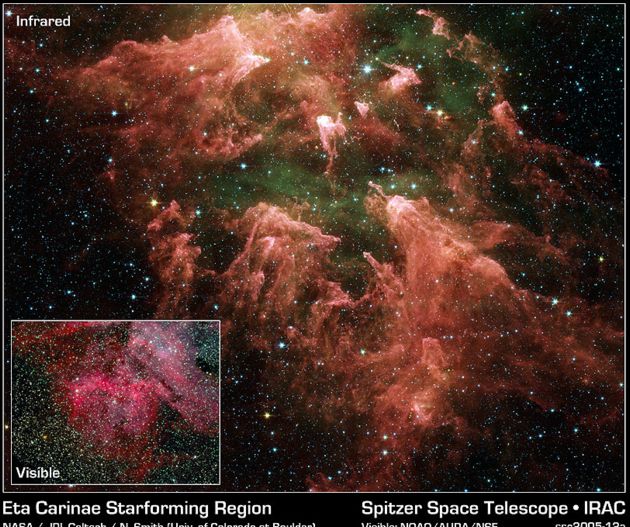Stars Born on Dusty Pedestals

MINNEAPOLIS, MN - As they destroy the huge cloud that is their home, wildly energetic stars may be triggering the birth of the next generation. In a fabulous image released yesterday, these new stars are found sitting atop giant pillars of gas and dust.
The stellar nursery in this case is the Carina Nebula - a cloud of gas and dust that is 200 light-years in diameter. Located in the southern part of our galaxy, Carina is 10,000 light-years from Earth.
At the American Astronomical Society meeting here, Nathan Smith of the University of Colorado, Boulder, presented new data on this nebula from NASA's Spitzer Space Telescope.
Spitzer's infrared eyes can see through the dust that blocks much of the visible light, revealing the ruinous effects of massive stars in the cloud's center.
"This is an image that illustrates how massive stars destroy the environment that they were born in," Smith said at the press conference.
The massive stars create powerful stellar winds and piercing ultraviolet radiation that have cleared out an immense cavity in the nebula. But through the cosmic yin and yang, this destructive action appears to have given birth to a host of smaller mass stars on the edge of the cavity.
These baby stars - in a sense - block the wind and radiation from their massive forebears, so that a trail of undisturbed gas and dust forms in their wake. The resulting finger-like pillars of dense cloud material extend up to 10 light years in length.
Get the Space.com Newsletter
Breaking space news, the latest updates on rocket launches, skywatching events and more!
The Spitzer image is reminiscent of the famous Hubble Space Telescope image of the Pillars of Creation in the Eagle Nebula.
Fierce contest
The Carina Nebula, which contains roughly 100,000 young stars, is about 100 times more luminous than the much closer Orion Nebula. Some of these stars are tearing the nebula to bits.
"There is a fierce contest going on," Smith said. "On one hand we have these massive, first-generation stars trying to remove all of this gaseous material, and the young stars like those embedded in the dust pillars are trying to accrete the material to build themselves up."
The most damaging of the first generation is Eta Carinae, a variable star that puts out more energy than one million Suns. It is sometimes touted as the stellar heavyweight champ - with a mass estimated to be over 100 solar masses.
Winds blow off Eta Carinae's surface at four million miles per hour. During a spectacular event in the 1840s, the star shed the equivalent of 10 solar masses from its outer layers. For several years after this sloughing off, Eta Carinae was the second brightest star in the sky.
There have been several other eruptions in the star's past - leaving astronomers to suspect that this powder keg will go supernova sometime in the next thousand years.
Because of its violent history, Eta Carinae is believed to have been the prime sculptor of the remarkable pillars in the Carina Nebula. This is evidenced by the fact that almost all of them extend in the direction away from Eta Carinae, like flags wafting in the star's wind.
Star trigger
Each of the pillars is home to one or more recently formed stars. All this stellar ignition is almost certainly due to Eta Carinae's activity, Smith said.
Star formation is excited in some nebulae by shock waves that travel at the speed of sound - which is approximately 7,000 mph in a space cloud. This is not fast enough, Smith said, to explain the synchronized star formation in the Carina Nebula.
Instead, it is more likely that the ultraviolet radiation and wind from Eta Carinae and its fellow massive stars has pushed gas and dust out "like a snowplow," explained Smith. At the edge of the cleared cavity, material piled up, and eventually formed knots where new stars could form.
The speed of this snowplow is estimated to be three times the speed of sound, Smith said, so this mechanism provides a reasonable explanation for the timing of the stellar embryos in the Carina Nebula.
All this could have interest for research that is closer to home.
"We think our solar system formed in one of these [nebula] environments," Smith said.
- Scorched! Planetary Seeds Fried by Superhot Stars
- Hubble Sees Huge Stellar Nursery in Nearby Galaxy
- The 10 Brightest Stars
Join our Space Forums to keep talking space on the latest missions, night sky and more! And if you have a news tip, correction or comment, let us know at: community@space.com.

Michael Schirber is a freelance writer based in Lyons, France who began writing for Space.com and Live Science in 2004 . He's covered a wide range of topics for Space.com and Live Science, from the origin of life to the physics of NASCAR driving. He also authored a long series of articles about environmental technology. Michael earned a Ph.D. in astrophysics from Ohio State University while studying quasars and the ultraviolet background. Over the years, Michael has also written for Science, Physics World, and New Scientist, most recently as a corresponding editor for Physics.